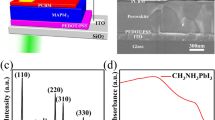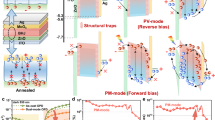Abstract
Organic semiconductor based photodetectors would be very attractive, innovative and well suited for light detection applications. The requirement of organic semiconductor in photonic device is to low cost, light weight, mechanical flexibility, chemical modification, tunability of absorption range with co-evaporation and co-mixing of molecules and easy to integrate. In fact, organic optoelectronics devices are more eco-friendly and energy efficient. In this research work, main objective is to fabricate and characterize organic semiconductor based photo detector with a proper choice of organic semiconductor as donor and acceptor and optimize by employing diversified organic semiconductors for fast response time, high photosensitivity, high quantum efficiency, low dark current, large dynamic range and long life time. The equivalent circuit model of the proposed organic photo detector (OPD) structure has been designed and simulated using MATLAB Simulink in which Rubrene and BPPC are used as active layer of OPD. 500 MHz of Operating frequency is to be found in this proposed OPD that is much higher than the speed of the red light illumined Bi-layer OPDs reported till today.



(Fig. reused from Ref. [10])

(Fig. reused from Ref. [10])

(Fig. reused from Ref. [10])

(Fig. reused from Ref. [10])

















Similar content being viewed by others
References
Sze SM (1981) Physics of semiconductor devices, 2nd edn. Wiley, New York
Konstantatos G, Sargent EH (2010) Nanostructured materials for photon detection. Nat Nanotechnol 5:391
Mueller T, Xia F, Avouris P (2010) Graphenephotodetectors for high-speed optical communications. Nat Photon 4:297
Mok SM, Yan F, Chan HLW (2008) Organic phototransistor based on poly (3-hexylthiophene)/TiO2nanoparticle composite. Appl Phys Lett 93:023310
Sun Z, Liu C, Yang S et al (2011) Enhancement of hole mobility of poly (3-hexylthiophene) induced by titania nanorods in composite films. Adv Mater 23:3648
Yan F, Li J, Mok SM (2009) Highly photosensitive thin film transistors based on a composite of poly(3-hexylthiophene) and titania nanoparticles. J Appl Phys 106:074501
Sun Z, Liu Z, Li J et al (2012) Infrared photodetectors based on CVD-grown graphene and PbS quantum dots with ultrahigh responsivity. Adv Mater 24:5878
Baeg KJ, Binda M, Natali D et al (2013) Organic light detectors: photodiodes and phototransistors. Adv Mater 25(32):4267
Clark J, Lanzani G (2010) Organic photonics for communications. Nat Photon 4:438
Wang Y (2014) Low threshold organic semiconductor lasers hybrid optoelectronics and applications as a explosive sensors. Springer, ISBN-978-3-319-01266-7
Peumans P, Bulovi V, Forrest SR (2000) Efficient, high-bandwidth organic multilayer photodetectors. Appl Phys Lett 76:3855
Morimune T, Kajii H, Ohmori Y (2006) Photoresponse properties of a high-speed organic photodetector based on copper-phthalocyanine under red light illumination. IEEE Photon Technol Lett 18(24):2262
Ohmori Y, Kajii H, Kaneko M et al (2004) Realization of polymeric optical integrated devices utilizing organic light-emitting diodes and photodetectors fabricated on a polymeric waveguide. IEEE J Sel Top Quantum Electron 10(1):70
Punke M, Valouch S, Kettlitz SW et al (2008) Optical data link employing organic light-emitting diodes and organic photodiodes as optoelectronic components. J Lightwave Technol 26(7):816
Arredondo B, Romero B, Pena JMS et al (2013) Visible light communication system using an organic bulk heterojunction photodetector. Sensors 13(9):12266
Tsai WW, Chao YC, Chen EC et al (2009) Increasing organic vertical carrier mobility for the application of high speed bilayered organic photodetector. Appl Phys Lett 95:213308
Yang D, Zhou X, Ma D (2013) Fast response organic photodetectors with high detectivity based on rubrene and C60. Org Electron 14(11):3019
Wang JB, Li WL, Chu B et al (2011) High speed responsive near infrared photodetector focusing on 808 nm radiation using hexadecafluoro-copper-phthalocyanine as the acceptor. Org Electron 12:34
Binda M, Agostinelli T, Caironi M et al (2009) Fast and air stable near infrared organic detector based on squaraine dye. Org Electron 10:1314
Binda M, Iacchetti A, Natali D et al (2011) High detectivitysquaraine-based near infrared photodetector with nA/cm2 dark current. Appl Phys Lett 98:073303
Chen EC, Chang CY, Shieh JT et al (2010) Polymer photodetector with voltage-adjustable photocurrent spectrum. Appl Phys Lett 96:043507
Wu SH, Li WL, Chu B et al (2011) High performance small molecule photodetector with broad spectral response range from 200 to 900 nm. Appl Phys Lett 99:023305
Menke SM, Pandey R, Holmes RJ (2012) Tandem organic photodetectors with tunable, broadband response. Appl Phys Lett 101:223301
Wang X, Li H, Su Z et al (2014) Efficient organic near-infrared photodetectors based on lead phthalocyanine/C60 heterojunction. Org Electron 15:2367–2371
Li Lisheng, Yuying H, Junbiao P et al (2014) Highly responsive organic near-infrared photodetectors based on a porphyrin small molecule. J Mater Chem C 2:1372–1375
Li L, Zhang F, Wang J et al (2015) Achieving EQE of 16,700% in P3HT:PC71BM based photodetectors by trap-assisted photomultiplication. Sci Rep 5:9181. doi:10.1038/srep09181
Su Z, Hou F, Wang X et al (2015) High-performance organic small-molecule panchromatic photodetectors. ACS Appl Mater Interfaces 7(4):2529
Yang D, Zhou X, Wang Y et al (2016) Deep ultraviolet-to-NIR broad spectral response organic photodetectors with large gain. J Mater Chem C 4:2160
Yotter RA, Wilson DM (2003) Review of Photodetector for Sensing Light Emitting Reporters in Biological System. IEEE Sens J 3(3):288
Borel T (2013) Top-contact lateral organic photodetectors for deep ultraviolet applications, thesis. Electrical and Computer Engineering—Nanotechnology, University of Waterloo, Waterloo, Ontario, Canada
Hammond WT (2011) Design and fabrication of organic semiconductor photodiodes. Thesis, The Graduate School of The University of Florida, University of Florida, Gainesville, Florida, United State
Higashi Y, Kim KS, Jeon HG (2010) Enhancing spectral contrast in organic red-light photodetectors based on a light-absorbing and exciton-blocking layered system. J Appl Phys 108:034502
Kettlitz SW, Mescher J, Christ NS et al (2013) Eliminating RC-Effects in transient photocurrent measurements on organic photodiodes. IEEE Photon Technol Lett 25(7):682
Swe TN, Yeo KS (2001) An accurate photodiode model for DC and high frequency SPICE circuit simulation. Nanyang Technological University, School of Electrical and Electronic Engineering Nanyang Avenue, Singapore, vol 1, ISBN 0-9708275-0-4, 368
Kim H, Gilmore CM, Pique A et al (1999) Electrical, optical and structural properties of indium–tin–oxide thin flims for organic light emitting devices. J Appl Phys 86:6451
https://en.m.wikipedia.org/wiki/Electrical_resistivity_and_conductivity
Barıs B, Ozdemir HG, Tugluoglu N et al (2014) Optical dispersion and dielectric properties of rubrene organi semiconductors thin flim. J Mater Sci Mater Electron 24(8):3586
Langhals H (1988) Dyes with high dielectric constants. Chem Phys Lett 150(3):321
Author information
Authors and Affiliations
Corresponding author
Rights and permissions
About this article
Cite this article
Nath, D., Dey, P., Deb, D. et al. Fabrication and characterization of organic semiconductor based photodetector for optical communication. CSIT 5, 149–160 (2017). https://doi.org/10.1007/s40012-016-0150-8
Received:
Accepted:
Published:
Issue Date:
DOI: https://doi.org/10.1007/s40012-016-0150-8




